Menu
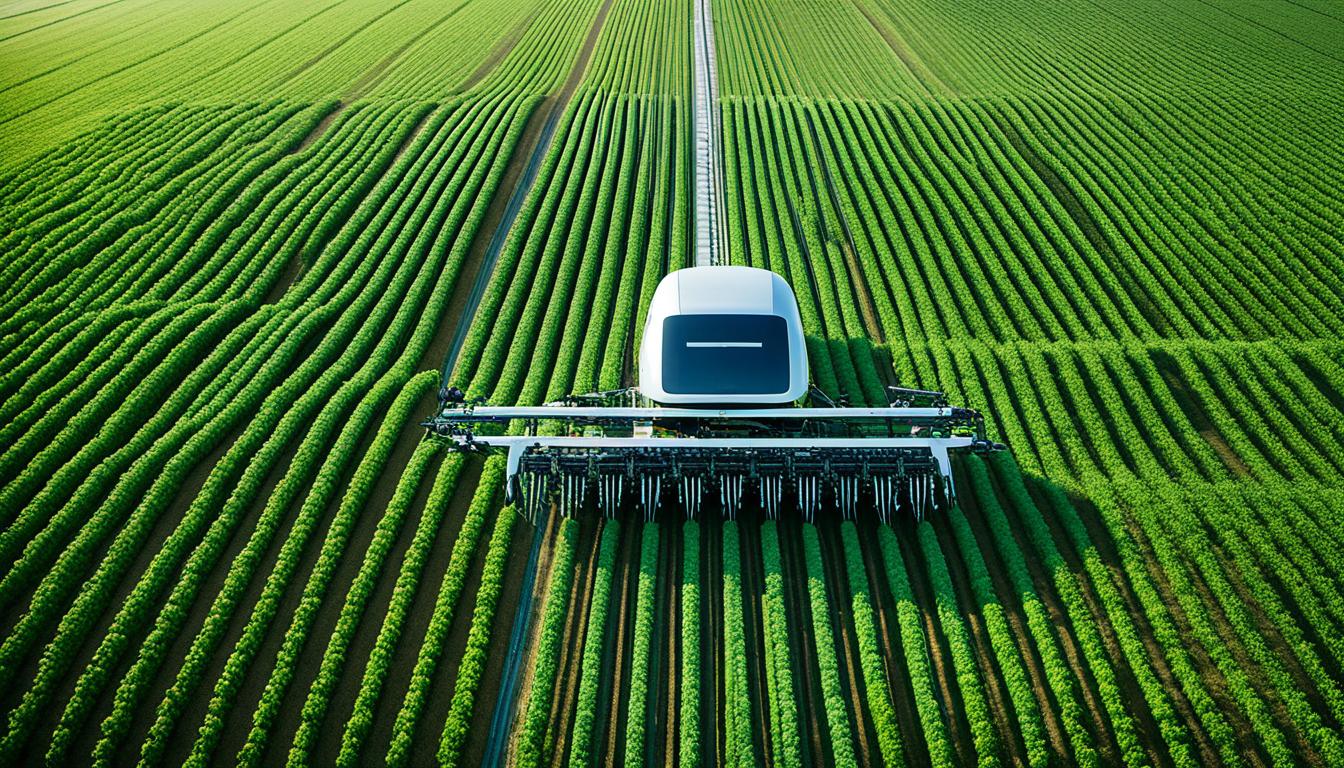
Do you know that no-till farming grows by 8% each year, saving soil? Many new technologies are changing farming today. The agricultural world is turning over new leaves, all because of advanced tech.
Tractors have become more than just working tools. They now boost farm work massively. With planters that can plant accurately, crops are growing better. This means we are getting more food from each field.
GPS guidance is making a big difference, saving fuel by 15% and planting better. Thanks to the latest tech, we can now see what the soil needs in real time. This helps crops by 10%. Also, we are using water better by 20%, which is great news for dry places.
The new farming tools are making a huge impact. They are making farms more efficient and friendly to the environment. Malika Agro Industries is helping lead this change with their advanced products.
From simple wooden tools to high-tech machinery, farming has come a long way. Early plowing tools, used by Sumerian farmers, set the stage for today’s farming machines. Over time, these tools evolved thanks to continuous innovation, bringing about great changes in agriculture.
Breakthroughs in farming history have been game-changers. Jethro Tull invented the seed drill, making planting easier by allowing farmers to plant in neat rows. Cyrus Hall McCormick’s mechanical reaper sped up the harvest process, saving a lot of time. John Deere introduced a self-cleaning steel plow, making soil preparation more efficient.
| Innovator | Invention | Impact |
|---|---|---|
| Jethro Tull | Seed Drill | Revolutionised planting, enabling row-based cultivation. |
| Cyrus Hall McCormick | Mechanical Reaper | Enabled large-scale grain harvesting, reducing labour. |
| John Deere | Steel Moldboard Plow | Increased efficiency in soil preparation. |
The advent of digital farming stands as a milestone in agricultural history. It uses GPS and variable rate seeding for precision planting. This transition shows how farming has moved from old methods to modern, digital techniques. Tractors have also evolved, becoming high-tech tools from basic machines.
Digital farming includes advanced GPS systems that guide tractors and planters precisely. This reduces seed wastage and leads to better harvests. Combining old farming methods with new technology creates an era of advanced, sustainable agriculture.
At the heart of modern farming, precision planting is key. It uses seed placement and technology to boost crop yields. With tools like Global Positioning Systems (GPS) and variable rate technology, it ensures each seed is placed right. This way, farms use resources wisely and grow better crops.
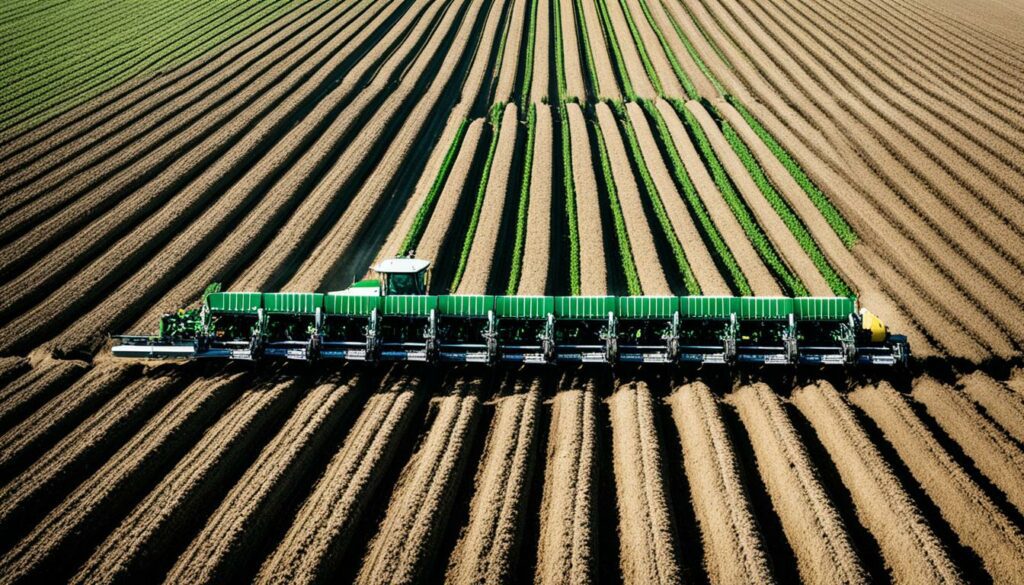
Gone are the days when farmers planted without knowing exactly where. Thanks to GPS, they can map fields accurately. This means they can set clear planting areas and avoid overlapping. As a result, they use seeds and fertilizers more efficiently. If something goes wrong, they can spot it right away and fix it fast.
Variable rate technology (VRT) goes a step further. It plants seeds based on up-to-the-minute soil and weather info. This means seeds go into the ground just right, helping crops grow evenly. The best part is, it cuts down on wasted supplies and is good for the environment. Farmers only use what they truly need, where they need it.
With GPS and VRT, precision planting is changing farming for the better. It means bigger harvests, smarter farming, and helping the planet. This is the power of modern agriculture.
Inertial Navigation Systems (INS) are changing the game in modern agriculture. They offer incredibly precise data. This leads to better use of resources and more sustainable farming practices. INS systems use special tools like accelerometers and gyroscopes. They are key in making farming activities more accurate. This includes planting, watering, and gathering crops.
In agriculture, Inertial Navigation Systems track equipment in real time. This ensures farm machines work very precisely. It means less overlap in work, saving resources. By adding sensors, these systems quickly spot problems like not enough water or pests. This lets farmers grow healthier crops and earn more.
INS is much better than the old ways of farming. It cuts down waste and helps use other new tech like drones. These all work together to make farming better. With INS data, farmers can plan when to plant, water, and deal with pests, using solid information. See below how INS is much more advanced:
| Aspect | Traditional Methods | INS Methods |
|---|---|---|
| Precision | Low | High |
| Resource Usage | High | Optimised |
| Data Utilisation | Minimal | Extensive |
| Operational Efficiency | Moderate | High |
Using INS in precision farming boosts crop growth and supports eco-friendly farming. Places like the United States and Europe are seeing big advantages. Yes, INS tech can be expensive and need training. But, as farming tech gets better, these challenges are getting smaller. This makes INS more available and easier to use for farmers.

The move to autonomous farming machinery is changing how farms operate. John Deere’s electric compact tractor, part of the 1R Series, is a great example. It can cut over 10,000 m² of grass in one go, using a battery that lasts 4.5 hours.
This step to automated farming cuts down on how much we need human workers. It makes farms work better and more efficiently.
At the heart of this change are autonomous tractors. John Deere’s concept for an electric self-driving tractor is powerful, with 500 kW. It can have wheels or tracks, depending on what’s needed. This tractor also has a smart transmission system that uses electrical power efficiently.These smart tractors can work alone in fields, making farming more productive. They cut costs and show where farming is heading with automation.
Harvesting is getting an upgrade with robotic harvesters. The S700 combine by John Deere can adjust itself during harvesting, keeping the cutting just right. This means workers always get top-quality crops from the fields.
Then there’s the large spraying drone designed by John Deere and Volocopter. It can cover a lot of land fast, up to 6ha/hr. These drones find weeds and spray the right amount of pesticide, using less chemicals.
| Equipment | Feature | Advantage |
|---|---|---|
| Electric Compact Tractor (John Deere 1R Series) | Mows over 10,000 m² with one charge; 4.5 hours battery life | Increased efficiency and reduced manual labour |
| Autonomous Tractor | 500 kW output; wheels or tracks | Flexibility and high performance |
| eAutoPowr Transmission | 100 kW electrical power for external use | Energy-efficient operation |
| Large Spraying Drone | Up to 6ha/hr coverage | High precision and reduced chemical use |
| Integrated Combine Adjust (S700) | Real-time automatic adjustments | Optimal and consistent harvesting |
The growth of autonomous farming machines is showing the way to a more high-tech future. With robots and automated tools leading the farm work, the future of farming looks full of innovation.
In today’s farming, innovative seed drills are changing how crops are planted. They use the latest technology to make sure seeds are placed just right. This helps seeds to grow better, which means more crops for farmers.
These special seed drills make a big difference for farmers:
| Aspect | Benefit |
|---|---|
| Increased Crop Yields | Using seed drills boosts crop yields by 20% to 25% more than the old way of planting by hand. |
| Efficient Land Use | With seed drills, farmers can use their land better, leading to 30% to 40% more crops growing in the same space. |
| Reduced Seed Wastage | Seed drills help reduce wasted seeds by preventing them from blowing away or being eaten by birds. This can lower waste by half. |
About 65% of farmers are now using mechanical seed drills because they work so well. Precision seed drills are extra special. They use GPS to plant seeds very accurately, with an error of less than 1%.
Farming equipment is always getting better. In the next five years, seed drill efficiency is expected to increase by 15%. New technologies, like self-driving seed drills and systems that use big data, will make farming more sustainable and precise.
The Case IH Precision Disk 500 series is a great example of these new machines. It’s made to help soybeans start growing early, which means more crops. The Precision Disk 550T also has a big tank, so farmers can work longer without stopping. This reduces the time the machines are not working, making farming more efficient.
Advanced technology is making soil management in agriculture better. It ensures each area of land is treated well to improve fertility and harvests. These tools are now a crucial part of farming, making significant gains in crop growth.
Soil health sensors and automatic soil testers are at the forefront. They constantly check soil, giving farmers up-to-the-minute data. This data helps ensure moisture, pH, and nutrients are perfect, which leads to strong plant growth and eco-friendly farming.
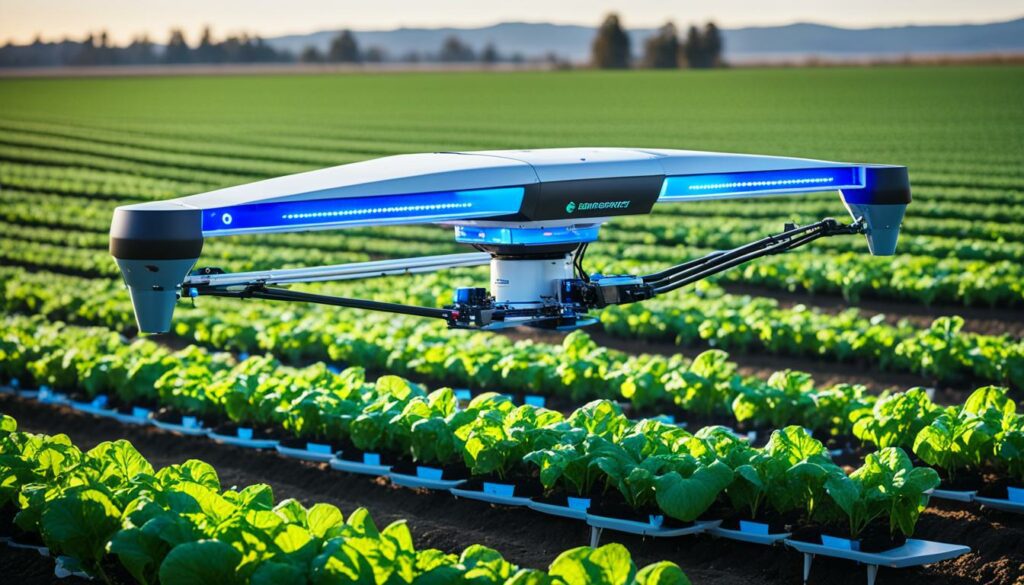
Today, farmers can pick from multiple high-tech tractors and vehicles, each for different tasks. Attachments like ploughs and harrows are key for soil prep and planting. They make tractors do more, coping with various soils and situations. Learn more about various farm equipment and their uses.
Soil health sensors are vital for smart farming. They give crucial info on soil, aiding in detailed analysis. By keeping an eye on moisture and nutrients, farmers can water and feed their crops better. This leads to healthier plants and saves resources.
Automated soil testing has changed how soil is checked, offering precise, quick results. It uses the latest tech to test soil on-site, saving time and hassle. Farmers get instant insight into their soil’s needs, helping them act fast to boost their harvests.
Overall, this high-tech soil management is a big leap for agriculture. It not only makes farming efficient but also helps the environment. This ensures we can get more from our land while looking after it for the future.
Next-generation harvesters play a key role in making farms more productive. These high-tech machines are boosting the way crops are gathered because of their new technology.
The S7 series of combines is a big step forward. They come with different engines for various jobs. The S7 700 has a 9-litre JD9X engine, while the S7 800, S7 850, and S7 900 have a powerful 13.6-litre JD14X engine.
The JD14X engine stands out for reaching full power at a low 2000 RPM. This not only increases how well they work but also saves on fuel and makes the machines last longer.
The JDLink™ technology inside these harvesters lets them connect with the John Deere Operations Center™. This means that data about the crops and how the machine’s performing is sent automatically. That’s a big step up in harvest technology.
They also have the StarFire™ receiver built in. It keeps the signal strong and steady with great accuracy. This makes the harvesters work precisely, leading to better crop gathering and less waste.
| Model | Engine |
|---|---|
| S7 700 | 9-litre JD9X |
| S7 800, S7 850, S7 900 | 13.6-litre JD14X |
| Max Power at Reduced Speed | 2000 RPM |
Looking into the future, John Deere’s 2025 updates will bring the newest harvesting automation to the X9 combines. They will add tech like grain sensing from the S7 and T series. This sets a fresh standard for advanced harvesting technology.
Using smart irrigation in farming is crucial for saving water. It employs technologies like drip irrigation to water plants directly at their roots. This method cuts down water waste and makes water use more efficient.
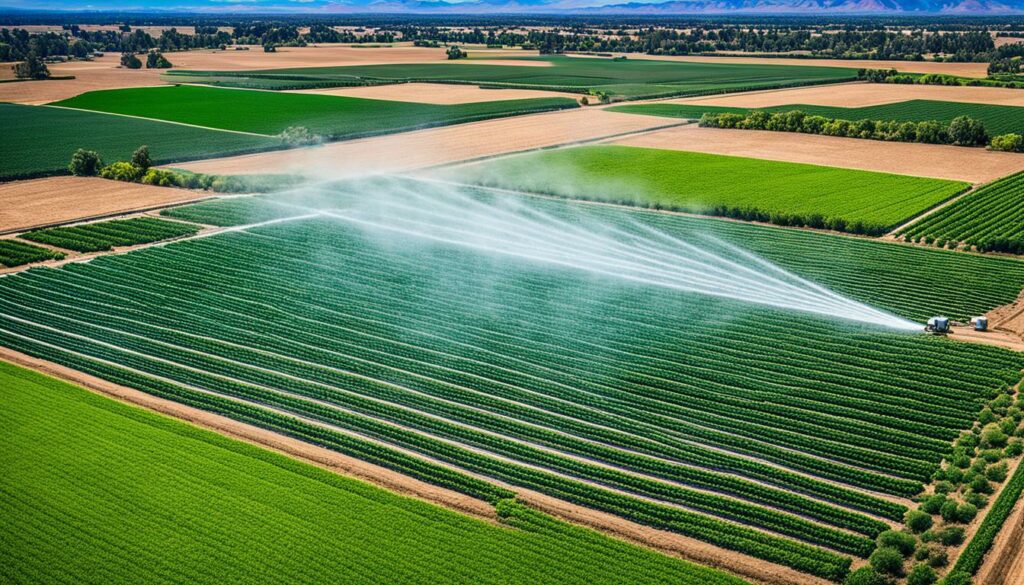
Drip irrigation is a top technology for saving water in farming. It can use 20% to 60% less water than flood systems. This can save homeowners up to 40% on their water bills. Also, it reduces the amount of chemicals that get into the environment by 70%. This is great for the planet.
IoT-connected drip systems can make crops grow better. They can improve water use, boosting crop yields by 20% to 50%.
Monitoring soil moisture is vital for smart watering systems. Sensors give real-time data, letting farmers water their plants just right. This reduces plant stress a lot and makes them healthier.
By automating watering, these systems can make landscaping companies 40% to 60% more efficient. The same data can also make farming more productive, increasing profits by 10% to 30%.
Here are some top advantages of smart irrigation:
| Benefits | Statistics |
|---|---|
| Water Usage Reduction | 30% to 60% |
| Water Bill Savings | 20% to 40% |
| Plant Stress Reduction | Up to 80% |
| Operational Efficiency | 40% to 60% Higher |
| Crop Yield Increase | 20% to 50% |
| Fertiliser and Pesticide Leaching Reduction | Up to 70% |
| Profitability Increase | 10% to 30% |
Using smart irrigation isn’t just good for water; it’s great for the planet, too. Companies like Zimmatic lead the way with smart solutions for farming.
The Internet of Things (IoT) is changing farming as we know it. It’s making agriculture more connected and smart. This is a big step towards better farming that’s more efficient and sustainable.
IOT in farming means using sensors and devices. These gadgets keep an eye on things like soil health or when it’s going to rain. They give farmers valuable tips, helping them make choices that increase productivity and the quality of the crops.
Studies show that by 2050, IoT and other high-tech farming will produce 69% more food. This is key because we’ll need more food for our growing world. The goal is to up food production by 70% in the next 30 years, and IoT is set to help meet this challenge.
IoT tools like drones and GPS systems are also making farming more exact. They help farmers plant at the best times, use water smarter, and spread fertilisers more accurately. This not only makes more food but uses fewer resources, making it good for the planet.
Smart farming, part of precision agriculture, uses IoT to tie different machines and sensors together. This creates an info-sharing network that boosts cost-effectiveness and productivity. It also means quicker access to key farming data.
| Technology | Function | Benefits |
|---|---|---|
| Sensors | Real-time soil and crop monitoring | Improved decision-making, increased productivity |
| GPS Equipment | Precision planting and geolocation tracking | Enhanced accuracy, reduced wastage |
| Drones | Field surveillance and crop health assessment | Efficient monitoring, early issue detection |
| Wearable Devices | Animal health and behaviour monitoring | Timely illness detection, improved livestock management |
IOT technology in agriculture is set to grow a lot by 2026, reaching $48.7 billion. This huge future market shows how essential IoT is for farming’s future. It helps overcome old farming problems, making a shift towards better, more sustainable farming.
Farm management software is key for today’s farmers. It gives them a tech boost in running their farms efficiently. With features that meet the needs of modern agriculture, this software streamlines many tasks.
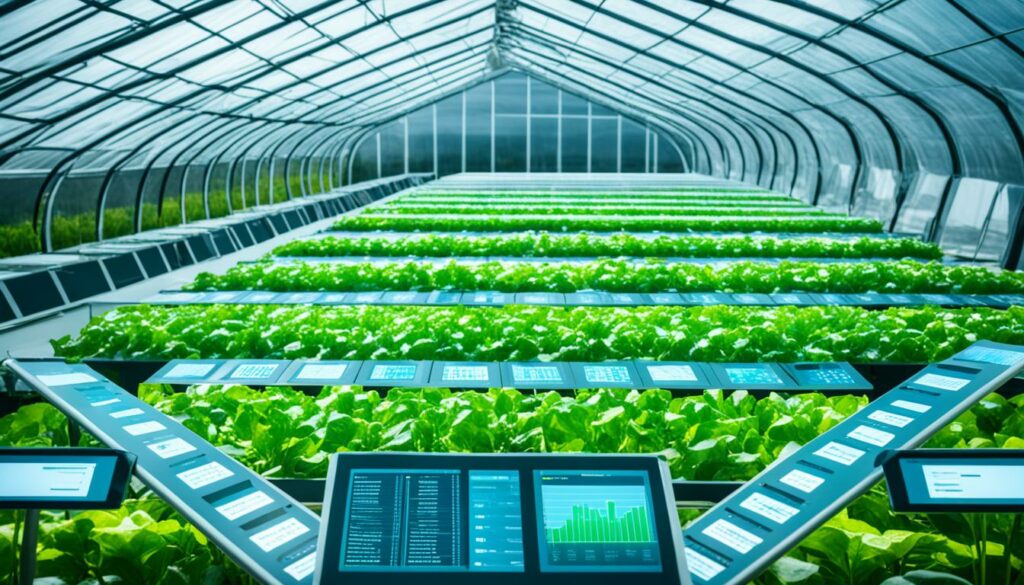
Farm management software shines in offering real-time agricultural data. It’s critical for tracking everything from crops to machinery. This monitoring lets farmers quickly adapt to keep their farms running well.
Decision-making in farming gets a big upgrade with this software. Farmers get deep analytics and insights to help make the best choices. Tools like customisable dashboards and remote access make farm management more flexible and efficient.
| Feature | SMS Basic | SMS Advanced |
|---|---|---|
| File Processing | Most precision ag displays | Most precision ag displays |
| Project Management | No | Yes |
| 3D Plotting | No | Yes |
| Satellite Imagery Analysis | Yes | Yes |
| Advanced Analysis Tools | No | Yes (including NDVI analysis) |
| Mobile App Syncing | Yes | Yes |
Advances in farm software like SMS Basic and SMS Advanced are changing farming methods. They boost daily work and help with planning and big decisions. As we aim for more sustainable farming, these kinds of software will be even more essential.
One-third of global energy is used in food production and processing today. This is why agriculture is turning more towards renewable energy. The move aims to make the industry sustainable and less dependent on traditional energy sources. Using renewable energy lowers greenhouse gas emissions and makes better use of resources.
Solar power is a great fit for farms, especially if they’re in sunny areas. Solar-powered irrigation systems are popular because they’re cheap to use and maintain. They reduce the need for fossil fuels and lower energy costs, helping farms be more eco-friendly. By 2027, the solar irrigation market is expected to be worth $3.2 billion.
Bioenergy generators turn farm waste into energy, cutting down on harmful emissions. This process also helps manage waste better. The market for bioenergy in agriculture is set to grow to $151.2 billion by 2028. These generators are key in a model that meets energy needs and cares for the environment.
Setting up renewable energy systems like solar, bioenergy, wind, or hydropower requires careful planning. Farming projects can get financial help and tax breaks. Also, selling extra power can generate income. The trick is to choose the right tech for a sustainable and money-saving solution.
Moving to renewable energy sources in farming has its hurdles, like the initial high costs and tech maintenance. But, the benefits in the long run, like savings on energy, less pollution, and being more resilient in blackouts, are significant. New tech, such as IoT and AI, is helping manage sustainable energy in farms. This is pushing agriculture towards a future that’s greener and more independent.
So many farm practices have changed because of precision agriculture tools. They are crucial for making crops better and the land healthier. Now, let’s look at three important components of modern precision agriculture.
Today, drones are changing how farms are looked after. They can check on crop health, spread fertiliser, and do tasks that once needed a lot of people. Drones take very detailed pictures and collect important information. For example, in the U.S., drones help watch over more than half the land where they grow crops like corn, rice, and cotton. This means farmers can be very exact in places where details used to be hard to get. Drone work saves time and makes farm jobs easier.
Satellites in space are a key part of modern farming. They give farmers a lot of data about their big fields. This data helps decide when to water, where to plant next, and how to look after the land. With satellite help, farmers can spot problems early, even from high above. This special view helps stop wasting resources and makes farming smarter.
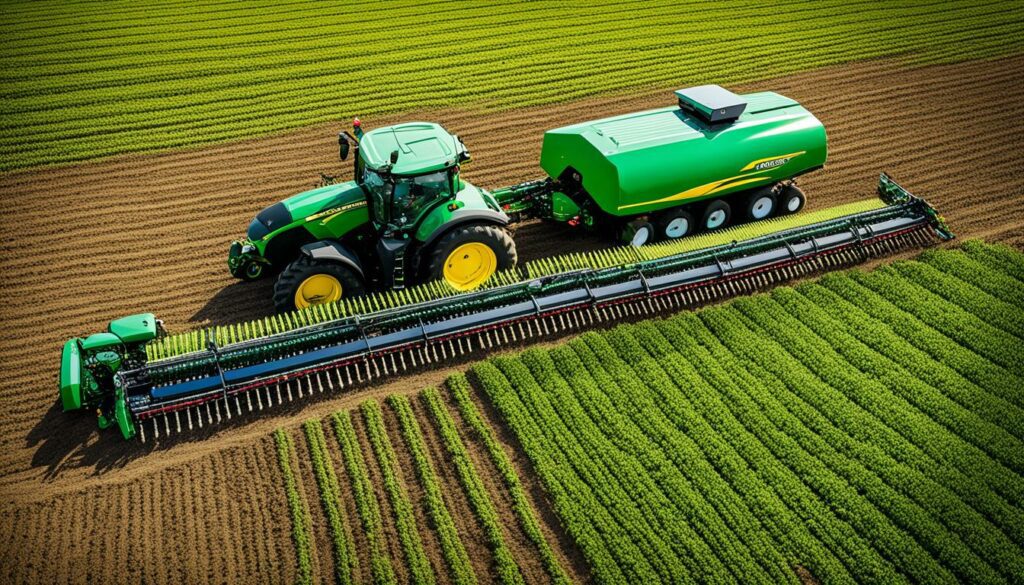
Soil sensors are very important because they can tell if the soil is just right. They give up-to-the-minute data on water, nutrients, and how warm the soil is. Farmers use this info to water and fertilise exactly where it’s needed. Modern tools like VRT make it easy to spray nutrients and pests only where they are needed. This way, the plants grow better, and it’s good for the environment too.
Using these advanced tools in farming helps save resources and makes more crops grow. Farming with these new technologies is good for the world, and it’s the way farming is heading. More and more, farmers will rely on these tools to keep their farms and the earth healthy.
The blend of high-tech planting gear and green farming methods is changing the game in farming. It ties in well with worldwide attempts to build stronger and greener food production ways. These tools are pushing up farm output and efficiency in big ways.
New machinery is leading the charge by making better use of resources and cutting down on damage to the Earth. By using environmentally friendly machines, farms are producing around 15% more crops. This shows just how well they work.
The benefits go beyond just growing more. The good these advancements do for our planet is amazing. When we look at the numbers, old farming gear is a lot worse for the environment. But with the latest tech, there’s a 35% drop in harm to the planet. This is huge for our Earth.
Let’s not forget about saving water. The newest planting tools are changing how we plant in ways that save water, helping to tackle water problems. As Sandro Esposito highlights, high-tech systems give farmers the info they need to use water better. This helps make farming more planet-friendly.
Here’s some hard data to back up these benefits:
| Aspect | Traditional Methods | Advanced Planting Equipment |
|---|---|---|
| Crop Yield Increase | 5% | 20% |
| Water Consumption Reduction | 20% | 50% |
| Carbon Footprint Reduction | 15% | 50% |
| Successful Implementation Rate | 40% | 90% |
| Farmers’ Adoption Rate | 30% | 70% |
| Pesticide Use | High | Low |
Farmers from all corners of the globe are getting on board with these new ways, and about 70% are now using advanced tools for eco farming. According to the National Academy of Sciences in 2017, the use of tech in agriculture is changing the game.
This change is boosted by cool tech like sensors, drones, and GPS gear that’s made for the fields. These tools are vital for making food safer worldwide, while also looking after our home planet.
The farming industry has changed a lot due to new technologies. These changes have made farming more efficient and sustainable. Modern farming equipment boosts crop yields by up to 25%.
Precision farming is key. It uses technology to improve how we grow crops. This includes using GPS to plant crops more accurately. Such tools help save fuel and make farming more eco-friendly.
Also, sensors and smart irrigation systems are used. They can tell when crops need water. This has improved crop health and yields. Water usage has become 40% more efficient too.
Drones help a lot with checking crops. They make monitoring crops easier and more effective. This, along with other digital tools, makes farming smarter and more efficient.
The future of farming is exciting. We’re heading towards Agriculture 5.0. With more technology, we can control things like weather and pests better. All these advances are making farming more sustainable and productive.
Advanced planting tools and seed drills have evolved farming. They use the latest tech to boost crop growth and cut waste. Thanks to GPS and varying seed rates, farms are both greener and more efficient.
Tractors are key to today’s farms, now highly advanced. They include GPS for planting accuracy and can work fields on their own. This helps farms produce more with less effort and cost.
GPS systems are crucial in planting precisely. They make sure seeds go exactly where they should. This boosts crop quality, saves resources, and increases the harvest.
Variable rate seeding means each seed is placed just right, depending on the land. This smart planting method ensures maximum growth and minimises waste. The result is a more bountiful harvest.
Inertial Navigation Systems (INS) improve farming’s accuracy and speed. They track machines’ exact positions and movements, avoiding mistakes and saving time. This makes farming more efficient overall.
Autonomous machines like tractors and harvesters work the fields on their own. They cut costs and effort, increasing the harvest and sustainability. They mark a big step forward in farm technology.
Advanced seed drills make sure seeds are planted just right. They boost the number of plants that grow, meaning more food. They’re key in feeding a growing population.
High-tech tools for the soil help farmers know exactly what their land needs. This means better treatments, which boosts the harvest. They help use the land fully and with care.
Next-gen harvesters are making harvests more efficient and precise. They cut post-harvest loss and do more in less time. They show the constant drive for innovation in farming.
Drip systems and moisture sensors bring just enough water directly to plants. This saves water and helps crops grow strong. They’re essential for keeping farming sustainable.
The Internet of Things makes farming smarter by connecting devices and collecting data. This data helps farmers make better choices, improving their success and care for the land.
Farm software gives up-to-the-minute info and insights for better farming decisions. This smart strategy lowers waste and raises efficiency, making farms more productive and sustainable.
Farms are using solar and bioenergy to power their operations. These renewable sources lower pollution, bring energy independence, and saves costs. They’re a big part of green farming.
Tools like drones, satellites, and soil sensors are the heart of precision farming. They give valuable data for smarter, greener farming. Together, they make farming more efficient and kind to the earth.
Advance planting tech helps farms do better without harming the environment. It focuses on saving resources and being eco-friendly. This is vital for making food production sustainable for the future.